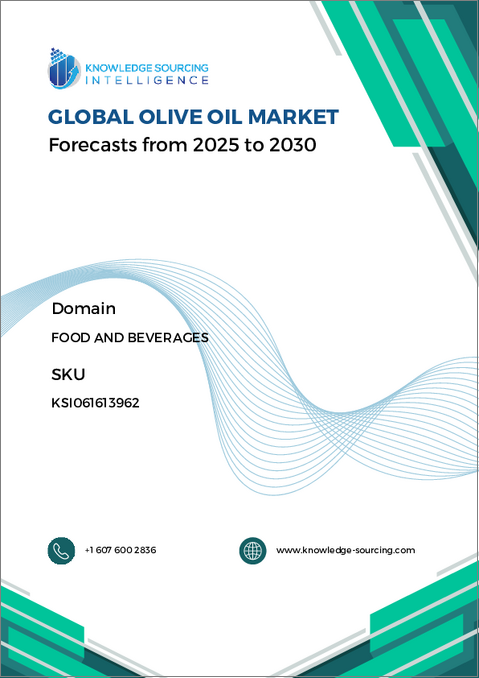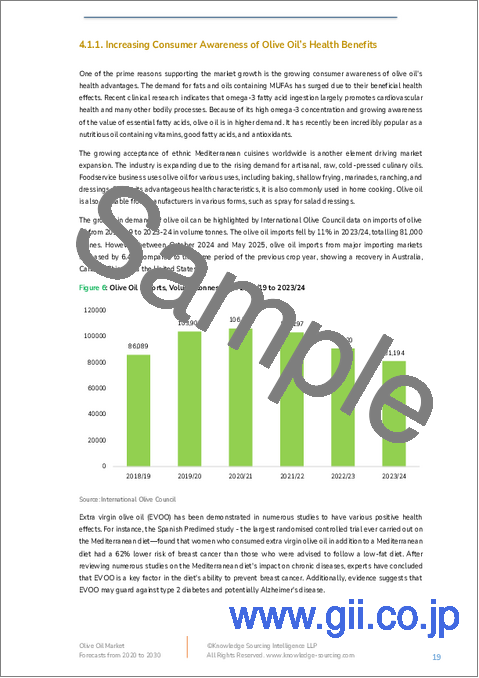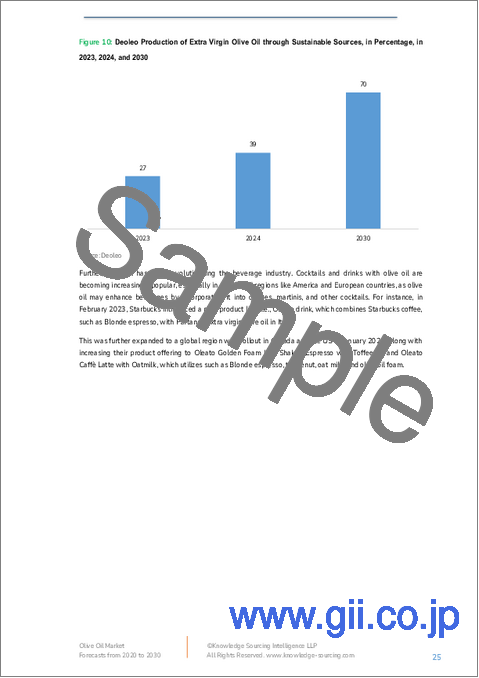|
|
市場調査レポート
商品コード
1627629
オリーブオイルの世界市場:予測(2025年~2030年)Olive Oil Market - Forecasts from 2025 to 2030 |
||||||
カスタマイズ可能
|
|||||||
| オリーブオイルの世界市場:予測(2025年~2030年) |
|
出版日: 2024年12月02日
発行: Knowledge Sourcing Intelligence
ページ情報: 英文 147 Pages
納期: 即日から翌営業日
|
全表示
- 概要
- 目次
世界のオリーブオイルの市場規模は、予測期間中にCAGR8.08%で成長し、2025年の129億1,400万米ドルから2030年には190億4,900万米ドルに達すると予測されています。
オリーブオイルは、オリーブの果実から抽出され、一般に、粉砕、圧搾、遠心分離、濾過、その他の様々な方法を用いた物理的または機械的プロセスによって製造されます。また、化学溶媒を使用して化学的に調製することもできます。しかし、管理された条件下で、機械的技術によって製造されたオリーブオイルを使用することが推奨されています。オリーブオイルは、食品、化粧品、医薬品など、世界中の様々な業界で使用されています。
オリーブオイルは、伝統的に欧州や地中海料理には欠かせない存在であり、世界的に脚光を浴びています。オリーブオイルには、心血管疾患、がん、糖尿病など、数多くの効能があります。欧州政府は、11月26日の「世界オリーブの日」を祝ったり、その他のマーケティングキャンペーンやスペインオリーブ協会などの業界団体を通じて、オリーブオイルをたびたび宣伝しています。
オリーブを天然資源として豊富に産出する国、主に地中海沿岸地域が、オリーブオイルとその変種の最大の生産国です。しかし、カリフォルニア、アルゼンチン、チリ、ペルー、南アフリカ、オーストラリアといった他の地域もオリーブに適した気候を持ち、オリーブオイルの産地として認められています。
WITS(World Integrated Trade Solution)によると、2023年のオリーブオイルとその副産物の輸入量のトップは米国で9,098万8,200Kg、次いでイタリア、スペインの3,483万2,100Kg、英国、ポルトガルの2,174万6,200Kgです。
次に、2023年におけるバージンオリーブオイルと副産物の輸入上位国は、イタリア、米国、スペイン、EU、フランスです。
イタリア農業食品統計研究所(ISMEA)、国際オリーブオイル協議会(IOC)、欧州委員会によると、2024~25年シーズンの世界のオリーブオイル生産量は、前シーズンの251万トンから23%、約58万8,000トン増加する可能性があります。
オリーブオイル市場の促進要因:
- 革新的で高品質なオリーブオイル製品の提供
オリーブオイルの需要は、欧州諸国および非欧州諸国において一定の割合で増加しています。メーカー各社は、高まる需要に応えるため、革新的な製品を提供し、オリーブオイルにガーリック、チリ、バジル、トリュフなどの天然香料やエキスを加えた製品を提供しています。ロンドン国際オリーブオイルコンペティションによるベストフレーバーオリーブオイル部門と高い製品品質が、この動きを後押ししています。
オリーブオイル市場の地理的展望
地域別では、オリーブオイル市場は北米、南米、欧州、中東・アフリカ、アジア太平洋に区分されます。アジア太平洋は、中国、日本、インド、韓国などの主要経済国が支配的です。急成長している新興国の中には、ASEAN諸国などこの地域のものもあります。
アジア太平洋では、オリーブオイル市場の顕著な成長が期待されています。2023年には、インドが169万3,890Kgのオリーブオイルとその副産物を輸入しました。オリーブオイルのこの成長は、化粧品産業の拡大、国内消費の増加、ライフスタイルの変化によるものです。
北米はオリーブオイルの大きな市場シェアを占めると予想されます。米国のバージンオリーブオイルおよび副産物の輸入は、2021年の11億8,412万9,000米ドルから2023年には16億5,741万5,000米ドルに拡大しています。この消費量の増加は、健康的な一価不飽和脂肪を豊富に含むという利点が知られているためです。
食の嗜好の変化に伴い、オリーブオイル貿易は欧州連合(EU)域外の国々で台頭してきました。しかし、欧州では毎年3~5%程度の安定した需要が続いています。さらに、オーストラリア、中国、日本、カナダも、オリーブオイルの消費において強い需要と成長を経験しています。
本レポートを購入する理由
- 洞察に満ちた分析:顧客セグメント、政府政策と社会経済要因、消費者嗜好、業界、その他のサブセグメントに焦点を当て、主要地域および新興地域を網羅する詳細な市場考察を得ることができます。
- 競合情勢:世界の主要企業が採用している戦略的作戦を理解し、正しい戦略による市場浸透の可能性を理解することができます。
- 市場動向と促進要因:ダイナミックな要因と極めて重要な市場動向、そしてそれらが今後の市場展開をどのように形成していくかを探ります。
- 実行可能な提言:ダイナミックな環境の中で新たなビジネスストリームと収益を発掘するための戦略的決断を下すために、洞察を活用します。
- 幅広い利用者に対応:新興企業、研究機関、コンサルタント、中小企業、大企業にとって有益で費用対効果が高くなっています。
どのような用途で利用されているか?
業界および市場考察、事業機会評価、製品需要予測、市場参入戦略、地理的拡大、設備投資の決定、規制の枠組みと影響、新製品開発、競合の影響
調査範囲
- 2022年~2030年の実績データと予測
- 成長機会、課題、サプライチェーンの展望、規制枠組み、顧客行動、動向分析
- 競合のポジショニング、戦略、市場シェア分析
- セグメントと各国を含む地域の収益成長と予測分析
- 企業プロファイル(主に戦略、製品、財務情報、主要な発展など)
目次
第1章 イントロダクション
- 市場概要
- 市場の定義
- 調査範囲
- 市場セグメンテーション
- 通貨
- 前提条件
- 基準年と予測年のタイムライン
- 利害関係者にとっての主なメリット
第2章 調査手法
- 調査デザイン
- 調査プロセス
第3章 エグゼクティブサマリー
- 主な調査結果
- アナリストの見解
第4章 市場力学
- 市場促進要因
- 革新的で高品質なオリーブオイル製品
- 国際的に認知されつつある地中海の文化と料理
- オリーブオイルの健康上の利点に関する認識の高まり
- 市場抑制要因
- 気候変動はオリーブオイル業界にとって危険
- ポーターのファイブフォース分析
- 業界バリューチェーン分析
第5章 オリーブオイル市場:製品タイプ別
- イントロダクション
- バージンオイル
- 精製オイル
- ポマスオイル
第6章 オリーブオイル市場:生産別
- イントロダクション
- 物理/機械的
- 化学的
第7章 オリーブオイル市場:流通別
- イントロダクション
- オフライン
- スーパーマーケット
- ハイパーマーケット
- その他
- オンライン
第8章 オリーブオイル市場:業界別
- イントロダクション
- 一般家庭
- 食品・飲料業界
- HoReCa業界(ホテル、レストラン、ケータリング)
- その他
第9章 オリーブオイル市場:地域別
- 世界の概要
- 北米
- 米国
- カナダ
- メキシコ
- 南米
- ブラジル
- アルゼンチン
- その他南米
- 欧州
- 英国
- ドイツ
- フランス
- イタリア
- スペイン
- その他欧州
- 中東・アフリカ
- サウジアラビア
- アラブ首長国連邦
- その他中東・アフリカ
- アジア太平洋
- 中国
- インド
- 日本
- 韓国
- 台湾
- タイ
- インドネシア
- その他アジア太平洋
第10章 競合環境と分析
- 主要企業と戦略分析
- 市場シェア分析
- 合併・買収・協定・協業
- 競合ダッシュボード
第11章 企業プロファイル
- Avril Group
- Albert Heijn
- Deoleo
- Sovena
- Borges
- Minerva
- Gallo
- Urzante
- Mercaoleo
The Olive Oil Market is expected to grow at a compound annual growth rate of 8.08% over the forecast period to reach a market size of US$19.049 billion in 2030 from US$12.914 billion in 2025.
Olive oil is extracted from the olive fruit and is generally manufactured by physical or mechanical processes using grind, press, centrifuge, filtration, and various other methods. It can also be prepared chemically by using chemical solvents. However, using the olive oils produced by mechanical techniques under supervised conditions is often recommended. Olive oil is used in various industry verticals, such as food, cosmetics, and pharmaceuticals worldwide.
Olive oil has traditionally been an inevitable part of European and Mediterranean cuisine, gaining prominence globally. It has numerous benefits, such as treating cardiovascular diseases, cancer, diabetes, etc. The European government has often promoted olive oil by celebrating World Olive Day on 26th November and other marketing campaigns and trade associations such as the Spanish Olive Interprofessional.
The market has been segmented based on the type into virgin oil, refined oil, standard oil, and crude oil; by production into mechanical and chemical. Based on distribution into business-to-business (B2B) and retail Individuals.
The nations abundant with olive as a natural resource, mainly beside the Mediterranean basin, are the largest producers of olive oil and its variants. However, other areas such as California, Argentina, Chile, Peru, South Africa, and Australia have favorable climates for olives and are recognized as olive oil producers.
According to the World Integrated Trade Solution (WITS), the top importers of olive oil and fractions in 2023 were the United States with 90,988,200 Kg imports, then Italy, followed by Spain with 34,832,100 Kg, the United Kingdom, and Portugal with 21,746,200 Kg of imports.
Secondly, the top importers of Virgin olive oil and fractions were Italy, the United States, Spain, the European Union, and France in 2023.
According to the Italian Institute for Agri-Food Statistics (ISMEA), the International Olive Oil Council (IOC), and the European Commission, the world olive oil production for the 2024/25 season could increase by 23% and by some 588,000 tonnes compared to the previous season, which stood at 2.51 million.
Olive oil market drivers:
- Innovative and higher-quality olive oil product offerings
The demand for olive oil is increasing at a constant rate within European and non-European countries. The manufacturers' rising demand calls for innovative product offerings, which are now serving olive oil with natural flavorings and added extracts such as garlic, chili, basil, truffle, and many others. The London International Olive Oil competition for the best-flavored olive oil category and high product quality supported the move.
Olive oil market geographical outlook
By geography, the olive oil market is segmented into North America, South America, Europe, the Middle East and Africa, and Asia Pacific. The major economies like China, Japan, India, and South Korea dominate the Asia-Pacific region. Some of the fastest-growing emerging economies are from this region, such as ASEAN countries.
The Asia Pacific region is expected to see notable growth in the olive oil market. In 2023, India imported 1,693,890 Kg of virgin olive oil and fractions. This growth in olive oil is due to the expanding cosmetic industry, increased domestic consumption, and changing lifestyle scenarios.
North America is expected to have a significant market share for olive oil. The United States import of virgin olive oil and fractions has expanded from US$1,184.129 million in 2021 to US$1,657.415 million in 2023. This increased consumption is due to the known benefits of richness in healthy monounsaturated fats.
With the changing food preferences, the olive oil trade has emerged in countries outside the European Union. However, Europe continues to exhibit stable demand of around 3-5% every year. Moreover, Australia, China, Japan, and Canada have also experienced strong demand and growth in the consumption of olive oil.
Reasons for buying this report:-
- Insightful Analysis: Gain detailed market insights covering major as well as emerging geographical regions, focusing on customer segments, government policies and socio-economic factors, consumer preferences, industry verticals, other sub- segments.
- Competitive Landscape: Understand the strategic maneuvers employed by key players globally to understand possible market penetration with the correct strategy.
- Market Drivers & Future Trends: Explore the dynamic factors and pivotal market trends and how they will shape up future market developments.
- Actionable Recommendations: Utilize the insights to exercise strategic decision to uncover new business streams and revenues in a dynamic environment.
- Caters to a Wide Audience: Beneficial and cost-effective for startups, research institutions, consultants, SMEs, and large enterprises.
What do businesses use our reports for?
Industry and Market Insights, Opportunity Assessment, Product Demand Forecasting, Market Entry Strategy, Geographical Expansion, Capital Investment Decisions, Regulatory Framework & Implications, New Product Development, Competitive Intelligence
Report Coverage:
- Historical data & forecasts from 2022 to 2030
- Growth Opportunities, Challenges, Supply Chain Outlook, Regulatory Framework, Customer Behaviour, and Trend Analysis
- Competitive Positioning, Strategies, and Market Share Analysis
- Revenue Growth and Forecast Assessment of segments and regions including countries
- Company Profiling (Strategies, Products, Financial Information, and Key Developments among others)
The Olive Oil Market is segmented and analyzed as below:
By Product Type
- Virgin Oil
- Refined Oil
- Pomace Oil
By Production
- Physical/ Mechanical
- Chemical
By Distribution
- Offline
- Supermarkets
- Hypermarkets
- Others
- Online
By Industry
- Retail Households
- Food and Beverage Industry
- HoReCa Industry (Hotels, Restaurants, and Catering)
- Others
By Geography
- North America
- USA
- Canada
- Mexico
- South America
- Brazil
- Argentina
- Rest of South America
- Europe
- United Kingdom
- Germany
- France
- Italy
- Spain
- Rest of Europe
- Middle East and Africa
- Saudi Arabia
- UAE
- Rest of the Middle East and Africa
- Asia Pacific
- China
- India
- Japan
- South Korea
- Taiwan
- Thailand
- Indonesia
- Rest of Asia-Pacific
TABLE OF CONTENTS
1. INTRODUCTION
- 1.1. Market Overview
- 1.2. Market Definition
- 1.3. Scope of the Study
- 1.4. Market Segmentation
- 1.5. Currency
- 1.6. Assumptions
- 1.7. Base and Forecast Years Timeline
- 1.8. Key benefits for the stakeholders
2. RESEARCH METHODOLOGY
- 2.1. Research Design
- 2.2. Research Process
3. EXECUTIVE SUMMARY
- 3.1. Key Findings
- 3.2. Analyst View
4. MARKET DYNAMICS
- 4.1. Market Drivers
- 4.1.1. Innovative and higher-quality olive oil product offerings
- 4.1.2. Mediterranean culture and cuisine are rising with international recognition
- 4.1.3. Growing awareness about the health benefits of olive oil
- 4.2. Market Restraints
- 4.2.1. Climate change perilous to the olive oil industry
- 4.3. Porter's Five Forces Analysis
- 4.3.1. Bargaining Power of Suppliers
- 4.3.2. Bargaining Power of Buyers
- 4.3.3. The Threat of New Entrants
- 4.3.4. Threat of Substitutes
- 4.3.5. Competitive Rivalry in the Industry
- 4.4. Industry Value Chain Analysis
5. OLIVE OIL MARKET BY PRODUCT TYPE
- 5.1. Introduction
- 5.2. Virgin Oil
- 5.3. Refined Oil
- 5.4. Pomace Oil
6. OLIVE OIL MARKET BY PRODUCTION
- 6.1. Introduction
- 6.2. Physical/ Mechanical
- 6.3. Chemical
7. OLIVE OIL MARKET BY DISTRIBUTION
- 7.1. Introduction
- 7.2. Offline
- 7.2.1. Supermarkets
- 7.2.2. Hypermarkets
- 7.2.3. Others
- 7.3. Online
8. OLIVE OIL MARKET BY INDUSTRY
- 8.1. Introduction
- 8.2. Retail Households
- 8.3. Food and Beverage Industry
- 8.4. HoReCa Industry (Hotels, Restaurants, and Catering)
- 8.5. Others
9. OLIVE OIL MARKET BY GEOGRAPHY
- 9.1. Global Overview
- 9.2. North America
- 9.2.1. United States
- 9.2.2. Canada
- 9.2.3. Mexico
- 9.3. South America
- 9.3.1. Brazil
- 9.3.2. Argentina
- 9.3.3. Rest of South America
- 9.4. Europe
- 9.4.1. United Kingdom
- 9.4.2. Germany
- 9.4.3. France
- 9.4.4. Italy
- 9.4.5. Spain
- 9.4.6. Rest of Europe
- 9.5. Middle East and Africa
- 9.5.1. Saudi Arabia
- 9.5.2. United Arab Emirates
- 9.5.3. Rest of the Middle East and Africa
- 9.6. Asia-Pacific
- 9.6.1. China
- 9.6.2. India
- 9.6.3. Japan
- 9.6.4. South Korea
- 9.6.5. Taiwan
- 9.6.6. Thailand
- 9.6.7. Indonesia
- 9.6.8. Rest of Asia-Pacific
10. COMPETITIVE ENVIRONMENT AND ANALYSIS
- 10.1. Major Players and Strategy Analysis
- 10.2. Market Share Analysis
- 10.3. Mergers, Acquisitions, Agreements, and Collaborations
- 10.4. Competitive Dashboard
11. COMPANY PROFILES
- 11.1. Avril Group
- 11.2. Albert Heijn
- 11.3. Deoleo
- 11.4. Sovena
- 11.5. Borges
- 11.6. Minerva
- 11.7. Gallo
- 11.8. Urzante
- 11.9. Mercaoleo





